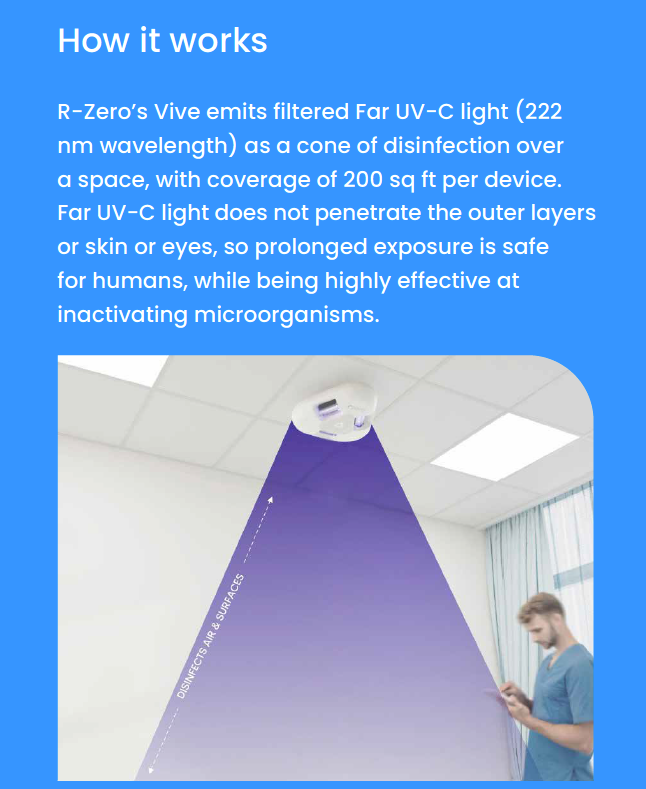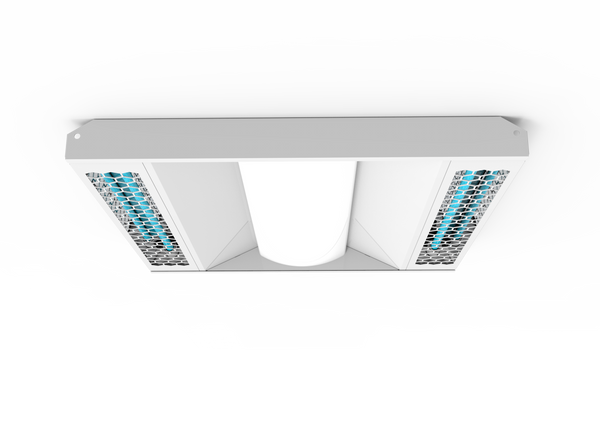Far-UVC UV Sanitizers: Enhancing Health Procedures with Precision and Effectiveness
Wiki Article
Far UVC Light: A Game-Changer in the Fight Versus Airborne Pathogens
In the ever-evolving battle versus air-borne pathogens, the appearance of far UVC light has actually sparked considerable interest and potential. What precisely is far UVC light, and how does it function?The Science Behind Far UVC Light
The scientific principles underlying using Far UVC light as a possible option for combating air-borne virus are both appealing and intricate. Far UVC light refers to a details variety of ultraviolet (UV) light wavelengths, commonly between 207 and 222 nanometers, which have been found to successfully kill or inactivate microbes such as infections and germs. Unlike traditional UVC light, which has a shorter wavelength and is recognized for its germicidal properties yet can likewise hurt human skin and eyes, Far UVC light has been revealed to be safe for human direct exposure.The vital system behind the efficiency of Far UVC light depend on its capability to permeate and destroy the genetic product of microbes, including their DNA and RNA. When exposed to Far UVC light, the genetic product undergoes a process called photodimerization, where nearby bases in the DNA or RNA molecule bind with each other, preventing duplication and providing the microorganism incapable to reproduce or cause infection.

Exactly How Far UVC Light Works
Far UVC light operates by making use of certain ultraviolet wavelengths to properly neutralize microorganisms and prevent their replication, making it an appealing service for combating airborne microorganisms. Unlike standard UVC light, which is damaging to human skin and eyes, far UVC light has much shorter wavelengths, generally in the array of 207 to 222 nanometers (nm), that do not penetrate the external layer of the skin or the tear layer of the eye. This makes it secure for continual human exposure, while still being deadly to microorganisms and viruses.The performance of much UVC light depend on its ability to destroy the dna and pass through and RNA of microbes. When subjected to far UVC light, the genetic product of these pathogens is damaged, providing them unable to replicate and contaminate cells. In addition, studies have actually shown that far UVC light can successfully suspend air-borne infections, such as influenza, measles, and coronaviruses, consisting of SARS-CoV-2, the virus accountable for COVID-19.
Additionally, far UVC light is also efficient in disinfecting surfaces and items in an encased area. By installing much UVC lights or utilizing portable far UVC light tools, it is feasible to continuously sanitize the air and surface areas, reducing the danger of airborne transmission of virus.
Advantages of Far UVC Light
Using far UVC light deals an array of substantial benefits in combating airborne microorganisms and making sure a safer environment for continual human direct exposure. Among the key benefits of far UVC light is its capability to efficiently neutralize different kinds of harmful microorganisms, visit here infections, and fungis without triggering harm to people. Unlike conventional UV light, which can be harmful to human skin and eyes, far UVC light has a shorter wavelength that enables it to target and destroy microorganisms while positioning very little danger to human health.
Additionally, much UVC light is much more secure for the atmosphere compared to conventional sanitation methods. Chemical anti-bacterials usually consist of unsafe active ingredients that can have adverse influence on the setting. Much UVC light, on the various other hand, does not generate any unsafe results or residues, making it a much more lasting and environmentally friendly remedy.
Applications of Far UVC Light
Far UVC light has actually confirmed to be effective in getting rid of air-borne microorganisms such as fungi, bacteria, and infections. Unlike traditional UV light, much UVC light is safe for human exposure, making it suitable for constant usage in public areas such as hospitals, offices, and schools.An additional application of much UVC light remains in the health care industry. It can be used to decontaminate healthcare facility rooms, running movie theaters, and clinical tools, minimizing the threat of healthcare-associated infections. In addition, far UVC light can be included right into cooling and heating systems to purify the air distributing in buildings, supplying an included layer of security versus air-borne microorganisms.
In addition, much UVC light can be utilized in the food industry to stop foodborne ailments. It can be employed to disinfect food handling centers, killing bacteria and various other microorganisms that might infect food.
Future Ramifications of Far UVC Light
The potential future applications of far UVC light are large and hold pledge for various industries and fields. Among the vital areas where far UVC light could have a significant impact is in healthcare settings. Health centers and clinics might make use of much UVC light to disinfect patient rooms, running movie theaters, and waiting locations, lowering the risk of healthcare-associated infections - far-uvc. This could possibly bring about improved person end results and decreased healthcare expenses.Additionally, making use of far UVC light directory in public areas such as airport terminals, train terminals, and mall might aid regulate the spread of airborne virus. By continuously decontaminating these areas, the threat of transmission might be substantially lowered, offering a safer environment for individuals.
Another prospective application of far UVC light remains in the food market. Much UVC light can be made use of to sanitize food preparation surfaces, product packaging materials, and storage areas. This can help avoid the contamination of food and lower the event of foodborne ailments.
Additionally, much UVC light can be utilized in a/c systems to sanitize the air distributing in buildings. This can be particularly beneficial in jampacked rooms such as offices, theaters, and schools, where the threat of airborne transmission is greater.
Conclusion
In conclusion, much UVC light has emerged as a game-changer in the battle versus air-borne microorganisms. From public spaces to health care setups, far UVC light offers countless advantages in lowering the transmission of illness.
you can check here Much UVC light refers to a specific array of ultraviolet (UV) light wavelengths, generally between 207 and 222 nanometers, which have been found to successfully kill or suspend microorganisms such as viruses and bacteria. far-uvc. Unlike conventional UVC light, which has a much shorter wavelength and is recognized for its germicidal residential or commercial properties yet can likewise harm human skin and eyes, Far UVC light has been shown to be secure for human direct exposure
Unlike standard UVC light, which is damaging to human skin and eyes, much UVC light has shorter wavelengths, typically in the variety of 207 to 222 nanometers (nm), that do not penetrate the outer layer of the skin or the tear layer of the eye. Unlike standard UV light, which can be hazardous to human skin and eyes, far UVC light has a much shorter wavelength that permits it to target and ruin pathogens while presenting marginal danger to human health and wellness.
Unlike traditional UV light, much UVC light is safe for human direct exposure, making it appropriate for continual use in public rooms such as hospitals, schools, and offices.
Report this wiki page